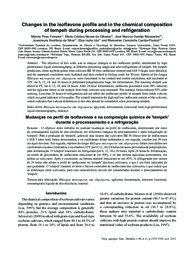Changes in the isoflavone profile and in the chemical composition of tempeh during processing and refrigeration.
Changes in the isoflavone profile and in the chemical composition of tempeh during processing and refrigeration.
Author(s): FERREIRA, M. P.; OLIVEIRA, M. C. N. de; MANDARINO, J. M. G.; SILVA, J. B. da; IDA, E. I.; CARRÃO-PANIZZI, M. C.
Summary: The objective of this work was to analyze changes in the isoflavone profile, determined by high performance liquid chromatography, at different processing stages and after refrigeration of tempeh. For tempeh production, clean soybean grains from cultivars BR 36 (low isoflavone content) and IAS 5 (high) were dehulled, and the separated cotyledons were hydrated and then cooked in boiling water for 30 min. Spores of the fungus Rhizopus microsporus var. oligosporus were inoculated in the cooked and cooled cotyledons, and incubated at 32ºC for 6, 12, 18, and 24 hours in perforated polypropylene bags, for fermentation. The resulting tempeh was stored at 4ºC for 6, 12, 18, and 24 hours. After 24‑hour fermentation, isoflavone glucosides were 50% reduced, and the aglycone forms in the tempeh from both cultivars was increased. The malonyl forms reduced 83% after cooking. Less than 24 hours of refrigeration did not affect the isoflavone profile of tempeh from either cultivar, which is a good indicator of its quality. The tempeh maintains the high and low isoflavone content of the cultivars, which indicates that cultivar differences in this trait should be considered when processing tempeh. Mudanças no perfil de isoflavonas e na composição química de tempeh durante o processamento e a refrigeração. O objetivo deste trabalho foi analisar mudanças no perfil de isoflavonas, determinado por meio de cromatografia líquida de alta eficiência, em diferentes estágios do processamento e após refrigeração de tempeh. Para a produção do tempeh, grãos de soja limpos das cultivares BR 36 (baixo teor de isoflavonas) e IAS 5 (alto teor) foram descascados, e os cotilédones foram hidratados e, em seguida, cozinhados por 30 min em água fervente. Em seguida, esporos do fungo Rhizopus microsporus var. oligosporus foram inoculados aos cotilédones cozidos e resfriados, e incubados a 32ºC por 6, 12, 18 e 24 horas em sacos perfurados de polipropileno, para fermentação. O tempeh resultante foi refrigerado por 6, 12, 18 e 24 horas. Após 24 horas de fermentação, os teores de glicosídeos de isoflavonas reduziram 50%, e os das formas agliconas aumentaram, em ambas as cultivares. Após o cozimento, as formas malonil reduziram 83%. A refrigeração por menos de 24 horas não afetou o perfil de isoflavonas no tempeh das duas cultivares, o que é um bom indicador de sua qualidade. O tempeh mantém os altos e baixos conteúdos de isoflavonas das cultivares, o que indica que as diferenças entre cultivares devem ser consideradas durante o processamento de tempeh.
Publication year: 2011
Types of publication: Journal article
Unit: Embrapa Soybean
Observation
Some of Embrapa's publications are published as ePub files. To read them, use or download one of the following free software options to your computer or mobile device. Android: Google Play Books; IOS: iBooks; Windows and Linux: Calibre.
Access other publications
Access the Agricultural Research Database (BDPA) to consult Embrapa's full library collection and records.
Visit Embrapa Bookstore to purchase books and other publications sold by Embrapa.

